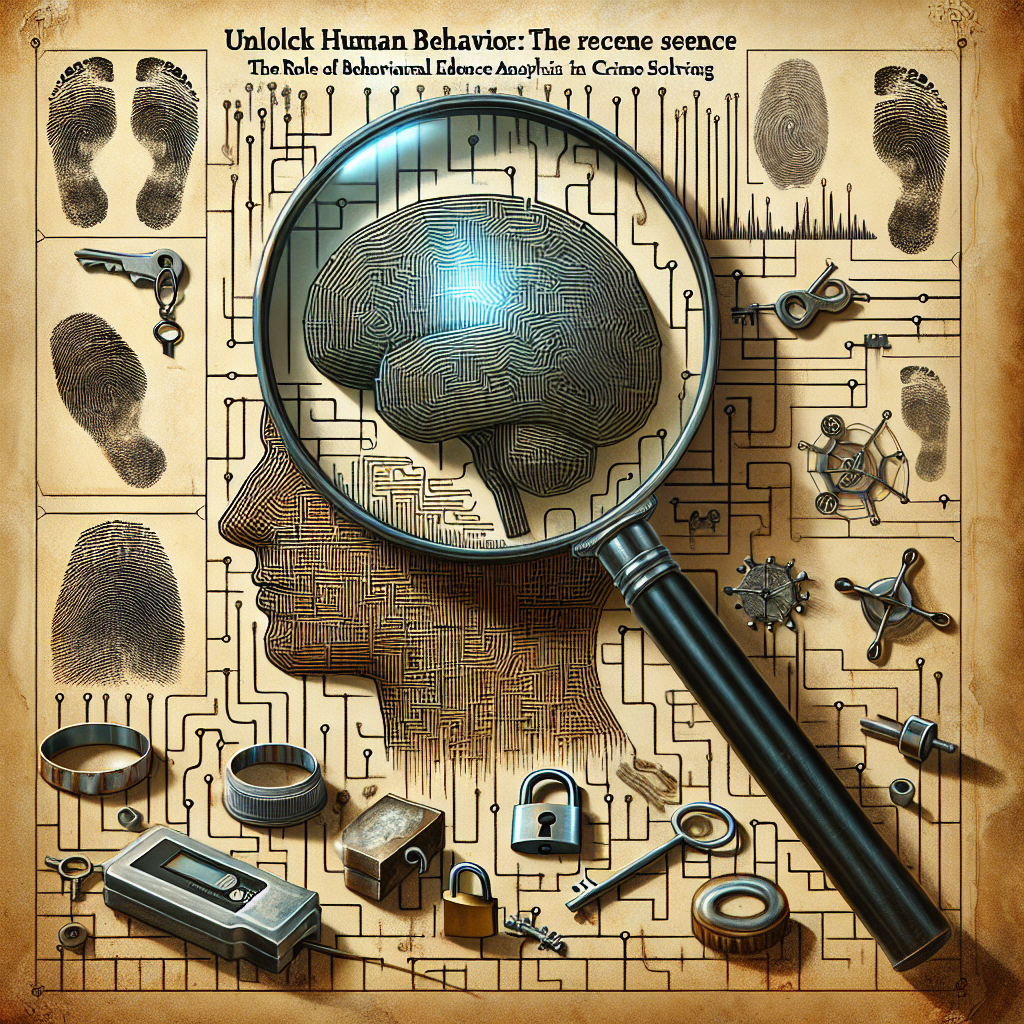
Introduction
In an era where crime-solving relies heavily on advanced technology and forensic science, Unlocking Human Behavior: The Role of Behavioral Evidence Analysis in Crime Solving emerges as a crucial yet often underappreciated aspect of criminal investigations. Behavior analysis offers unique insights that help law enforcement understand not only the ‘how’ but also the ‘why’ behind criminal acts. The nuances of human behavior can shed light on motives, predict future offenses, and even lead to the identification of suspects.
Imagine a crime scene—chaotic, with evidence scattered across the floor. Amid the investigation, officers note not just the hard evidence, but also the behavior of witnesses, suspects, and even the victims. This meticulous analysis can lead to breakthroughs in understanding crime patterns and motives. By studying behavioral evidence, detectives can piece together a narrative that transcends mundane facts, ultimately revealing the intricate web of human motivation.
This article dives deep into the significance of behavioral evidence analysis in crime-solving, providing valuable insights, compelling case studies, and effective strategies for law enforcement professionals.
Understanding Behavioral Evidence Analysis
What is Behavioral Evidence Analysis?
Behavioral evidence analysis (BEA) leverages psychological principles to interpret behavioral patterns associated with criminal activities. It involves examining the actions, decisions, and emotions of individuals involved in a crime, from perpetrators to victims. The goal is to create a comprehensive profile that explains not just what happened, but why it happened.
Key Components of BEA:
- Behavioral Patterns: Identifying common behaviors shared among different offenders.
- Psychological Profiling: Understanding the mindset and motivations of suspects.
- Victimology: Studying the characteristics of victims to understand the dynamics of the crime.
The Importance of Behavioral Evidence Analysis in Crime Solving
Unlocking Human Behavior: The Role of Behavioral Evidence Analysis in Crime Solving is underscored by its potential to augment traditional investigative methods. Here are several reasons why BEA is indispensable:
- Enhanced Understanding of Motivation: Recognizing underlying emotions, fears, and desires that drive criminal behavior.
- Predictive Insights: Anticipating future criminal activity based on behavioral trends.
- Suspect Profiling: Narrowing down suspect lists by matching behavioral characteristics with known offenders.
Case Studies: Real-World Applications of Behavioral Evidence Analysis
1. The Unabomber Case
The FBI’s investigation into Ted Kaczynski, aka the Unabomber, provides an illuminating example of BEA in action. Behavioral analysts meticulously studied Kaczynski’s manifesto and prior actions to construct a psychological profile.
Analysis:
- Behavior Patterns: Kaczynski’s targeted approach towards academia indicated a deep-seated resentment towards technological advancements.
- Predictive Elements: Analysts used his writings to predict future target demographics, ultimately leading to Kaczynski’s identification.
2. The BTK Killer
Dennis Rader, the BTK Killer, remained undetected for decades due to the nature of his tormenting behavior which included sending taunting letters to the police. Behavioral evidence analysis was pivotal in understanding his need for control and attention.
Analysis:
- Profiling Techniques: Investigators utilized his letters to decode his emotional state, understanding that he derived pleasure from the media coverage of his crimes.
- Insights Gained: Identifying his desire for recognition allowed police to anticipate his moves, leading to eventual capture.
3. The Golden State Killer
In one of the most notorious unsolved cases in American history, the Golden State Killer was apprehended using genetic genealogy in conjunction with behavioral analysis. Investigators connected a pattern of burglaries, rapes, and murders across California.
Analysis:
- Victimology: By studying the victims’ demographics, investigators formulated theories on the killer’s personal life and preferences.
- Behavioral Patterns: The meticulous MO highlighted a strategic planner, allowing law enforcement to work backwards to find connections.
The Process of Behavioral Evidence Analysis
Gathering Behavioral Evidence
Effective BEA begins with systematic data collection, focusing on various sources like:
- Crime scene evidence
- Suspect interviews
- Witness accounts
Analyzing Behavioral Data
Once collected, investigators analyze the data to identify:
- Motivational Insights: What drives the criminal’s behavior?
- Behavioral Consistencies: Are there patterns that align with other known crimes?
Constructing Profiles
Using the data, investigators build profiles that can help narrow down suspects. This may involve:
- Creating Behavioral Profiles: Outlining the likely traits of the offender.
- Using Technology: Implementing software that can analyze patterns in data efficiently.
Investigative Techniques
Innovative investigation techniques that benefit from BEA include:
- Interrogation Strategies: Tailoring questions based on behavioral profiles.
- Crime Trend Analysis: Utilizing historical data to predict future behavior.
The Role of Technology in Enhancing Behavioral Evidence Analysis
AI and Machine Learning
The integration of AI allows investigators to analyze vast amounts of behavioral data quickly. Machine learning can identify patterns that may not be immediately apparent to human analysts, thus speeding up investigations.
Behavioral Analysis Software
Several software platforms help law enforcement agencies in the process of BEA:
- Predictive Policing Tools: Using data mining to predict potential crime hotspots.
- Profiling Algorithms: Tools that create offender profiles based on historical data.
Ethical Considerations
While technology enhances BEA, ethical considerations must be taken into account:
- Privacy Concerns: Balancing crime fighting with individuals’ rights to privacy.
- Bias in Algorithms: Ensuring that AI does not perpetuate existing biases in policing.
Challenges Facing Behavioral Evidence Analysis
Despite its critical role, BEA faces several challenges:
Subjectivity
The interpretation of behavioral evidence can sometimes be subjective, leading to potential misjudgments or false accusations.
Resource Limitations
Not all law enforcement agencies have access to trained behavior analysts, making it difficult to implement BEA on a wide scale.
Evolving Criminal Techniques
As criminals evolve, so too must the methods used to analyze their behavior, creating a continuous need for adaptation in law enforcement strategies.
Conclusion
Unlocking Human Behavior: The Role of Behavioral Evidence Analysis in Crime Solving represents an essential dimension of criminal investigations. By understanding the underlying motivations, patterns, and behaviors associated with crime, law enforcement can make more informed decisions, ultimately increasing the chances of solving cases.
As society leans more into data-driven solutions, embracing the significance of BEA will enhance not only the efficiency of criminal investigations but also the safety of communities. Moving forward, it is essential for investigators to integrate behavioral analysis with traditional methods, ensuring a comprehensive approach to crime-solving.
Motivational Takeaway
In the words of renowned criminal psychologist, Dr. John McGowan, "Understanding human behavior isn’t just a tool for law enforcement; it’s a key to anticipate and prevent crime before it happens." A commitment to behavioral analysis can transform the way we tackle crime, making every community a safer place.
FAQs
1. What is behavioral evidence analysis?
Behavioral evidence analysis is a method that uses psychological principles to interpret behaviors associated with criminal activities, aiming to understand the underlying motives and predict future actions.
2. How does behavioral evidence analysis help in solving crimes?
By analyzing behavioral patterns, investigators gain insights into criminal motivations, helping to construct profiles and narrow down suspects, which facilitates quicker resolution of cases.
3. Are there ethical concerns related to behavioral evidence analysis?
Yes, there are ethical concerns regarding privacy, the potential for bias in profiling, and the implications of using technology in criminal investigations.
4. Can technology enhance behavioral evidence analysis?
Absolutely! AI and machine learning can significantly improve the efficiency and accuracy of analyzing behavioral data, identifying patterns that may go unnoticed.
5. What are some challenges in implementing behavioral evidence analysis in law enforcement?
Challenges include subjectivity in interpretation, resource limitations, and the need for continuous adaptation to evolving criminal techniques.
This exploration into Unlocking Human Behavior: The Role of Behavioral Evidence Analysis in Crime Solving is just the beginning. Engaging in this field not only enables law enforcement to solve existing crimes but also paves the way for a proactive approach to crime prevention.















